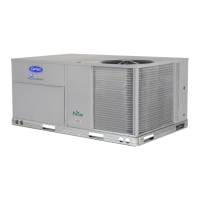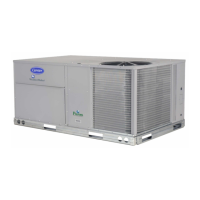151
Fig. 37 — CCN System Architecture
SERVICE
Service Access
All unit components can be reached through clearly labeled
hinged access doors. These doors are not equipped with tie-
backs, so if heavy duty servicing is needed, either remove them
or prop them open to prevent accidental closure.
Each door is held closed with 3 latches. The latches are secured
to the unit with a single
1
/
4
-in. –20 x
1
/
2
-in. long bolt. See
Fig. 38.
To open, loosen the latch bolt using a
7
/
16
-in. wrench. Pivot the
latch so it is not in contact with the door. Open the door. To
shut, reverse the above procedure.
NOTE: Disassembly of the top cover may be required under spe-
cial service circumstances. It is very important that the orientation
and position of the top cover be marked on the unit prior to disas-
sembly. This will allow proper replacement of the top cover onto
the unit and prevent rainwater from leaking into the unit.
Fig. 38 — Door Latch
NETWORK
OPTIONS
REMOTE
CCN SITE
AUTODIAL
GATEWAY
NON CARRIER
HVAC
EQUIPMENT
TERMINAL
SYSTEM
MANAGER
TCU
ROOFTOP
UNIT
DAV AIR
TERMINAL
TCU
TCU
DAV AIR
TERMINAL
AIR DISTRIBUTION-DIGITAL AIR VOLUME CONTROL (DAV)
DAV FAN
POWERED
MIXING
BOX
TO
ADDITIONAL
TERMINALS
HEATING/COOLING UNITS
BUILDING SUPERVISOR
ROOFTOP
UNIT
CL
ROOFTOP
UNIT
CL
ROOFTOP
UNIT
CL
ROOFTOP
UNIT
CL
CCN BUS
CL
COMFORT
CONTROLLER
LEGEND
CCN — Carrier Comfort Network
®
CL — ComfortLink™ Controls
DAV — Digital Air Volume
HVAC — Heating, Ventilation, and Air Conditioning
TCU — Terminal Control Unit
IMPORTANT: After servicing is completed, make sure
door is closed and relatched properly, and that the latches
are tight. Failure to do this can result in water leakage into
the indoor-air section of the unit.

